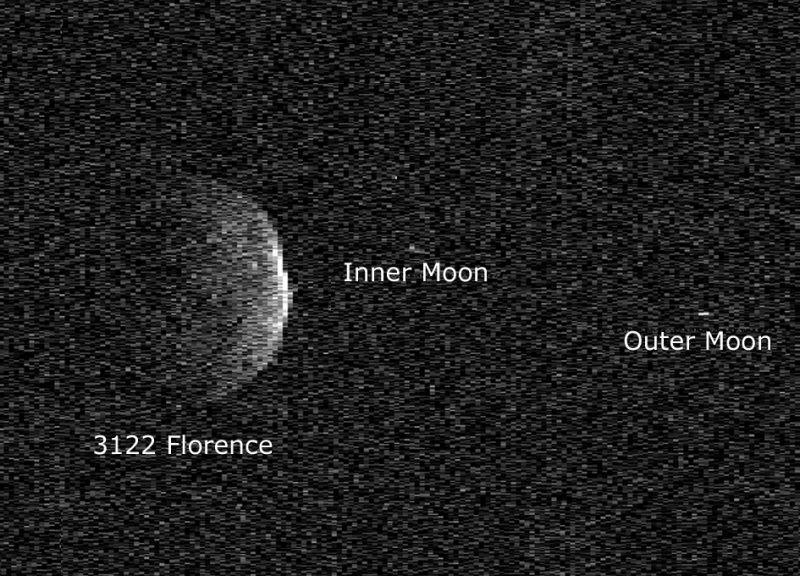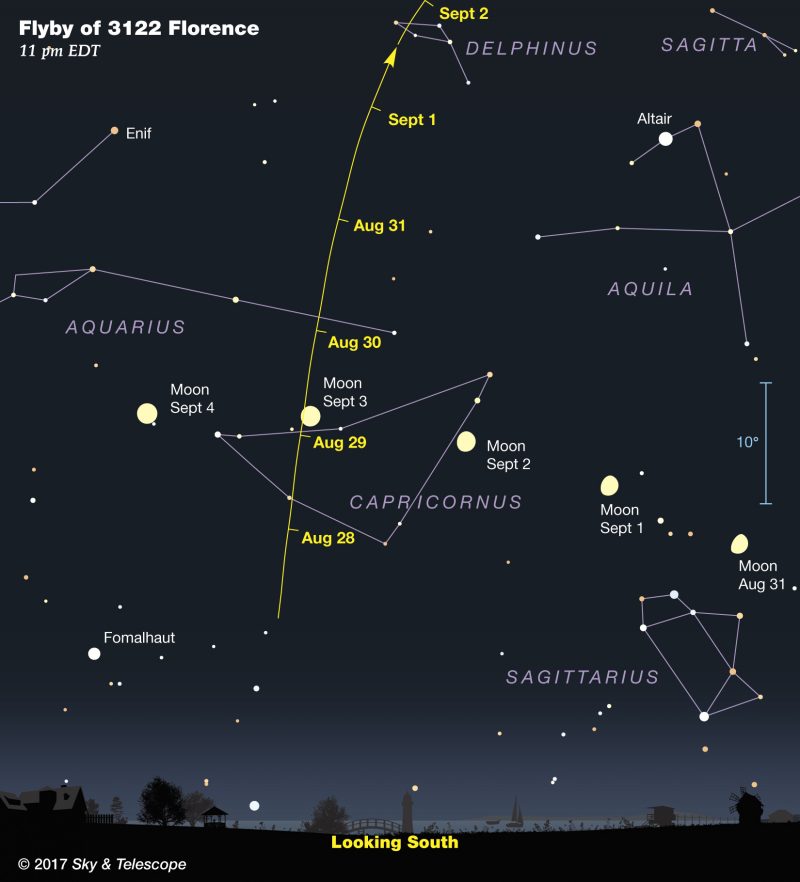
Asteroid 3122 Florence – largest asteroid to pass so close in over a century – swept past Earth on September 1, 2017. As it did so, astronomers using radar found that it is orbited by two tiny moons! According to a September 1 statement from the Center for Near Earth Object Studies (CNEOS):
Radar images of asteroid 3122 Florence obtained at the 70-meter antenna at NASA’s Goldstone Deep Space Communications Complex between August 29 and September 1 have revealed that the asteroid has two small moons, and also confirmed that main asteroid Florence is about 4.5 km (2.8 miles) in size. Florence is only the third triple asteroid known in the near-Earth population out of more than 16,400 that have been discovered to date. All three near-Earth asteroid triples have been discovered with radar observations and Florence is the first seen since two moons were discovered around asteroid 1994 CC in June 2009.
The sizes of the two moons are not yet well known, but they are probably between 100 – 300 meters (300-1000 feet) across. The times required for each moon to revolve around Florence are also not yet known precisely but appear to be roughly 8 hours for the inner moon and 22 to 27 hours for the outer moon. The inner moon of the Florence system has the shortest orbital period of any of the moons of the 60 near-Earth asteroids known to have moons. In the Goldstone radar images, which have a resolution of 75 meters, the moons are only a few pixels in extent and do not reveal any detail.

Asteroid 3122 Florence was discovered on March 2, 1981 from the Siding Spring Observatory in Australia. It is named in honor of Florence Nightingale (1820-1910), the founder of modern nursing. It passed safely at over 18 times the Earth-moon distance. It won’t come this close again until after the year 2500.
See images and video of asteroid 3122 Florence
Want to observe the asteroid from your backyard? Skyandtelescope.com offers great charts like the one below.

Professional astronomers have scheduled radar observations of Florence from NASA’s Goldstone Radar between August 29 to September 8, 2017. The Arecibo Observatory will also analyze Florence with radar from September 2 – 5, 2017. Astronomers had said that Florence provided them with an excellent opportunity to make detailed measurements of a large near-Earth asteroid. The recent statement said:
The radar images … provide our first close-up view of Florence itself. Although the asteroid is fairly round, it has a ridge along its equator, at least one large crater, two large flat regions, and numerous other small-scale topographic features. The images also confirm that Florence rotates once every 2.4 hours, a result that was determined previously from optical measurements of the asteroid’s brightness variations.
Among the near-Earth asteroids classified as Potentially Hazardous, Florence is one of the biggest. Bigger asteroids include 1999 JM8 (4.3 miles or 7 km), 4183 Cuno (3.5 miles or 5.6 km) and 3200 Phaeton (3.2 miles or 5.1 km), which is thought to be the parent body of the Geminid meteor shower.
Of these, however, Florence is brightest, making it an excellent target for possible glimpses via small telescopes and binoculars.
Its size of about half the elevation of Mount Everest has allowed it to reach a visual magnitude of +8.75 to +9, making it a relatively easy target for experienced observers at sites with dark skies.
Its distance will make it difficult to detect its slow motion across the stars, unless you are using at least a 5″ diameter or bigger telescope and observe in the right direction.
Although asteroid Florence is travelling at 30,266 miles per hour (48,708 km/h), the distance will make it appear so slow that observers should keep watching the fairly bright asteroid for about 5 to 10 minutes to detect its movement across the stars.

Bottom line: Asteroid 3122 Florence safely passed by our planet on September 1, 2017 at 18 times the Earth-moon distance. It’s the largest asteroid to pass this close to our planet since the first near-Earth asteroid was discovered over a century ago. Radar revealed two moons for Florence! The asteroid is visible to observers at dark sites using small telescopes. Chart in this post.











